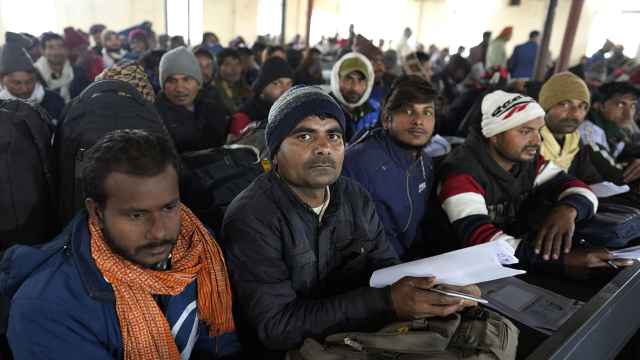The California summit between U.S. President Barack Obama and Chinese President Xi Jinping on June 7-8 comes at a time of heightened tension between the world's two preeminent powers. But divisive issues — from computer hacking to the U.S. "pivot" to Asia — must not claim all of the attention. If Obama and Xi lift their heads above the parapets and begin charting a jointly agreed course through the coming decade, they may find that they have much in common.
The next 10 years will be characterized by major structural adjustments, shifts in individual economies and by a huge reconfiguration of the global economy as a whole. Above all, much depends on the policies adopted by the two largest economies, China and the U.S., and their cooperation and leadership in creating global public goods and maintaining a stable and open economic environment.
Cooperation will be needed in many areas. One is the management of natural resources and the environment. The growth of China and the developing world will lead to a doubling of global output in 10 or 15 years, and probably a tripling in the 15 years after that. The growth model on which both advanced and developing countries relied in the past will not work at two or three times the scale. Climate, ecology, food, water, energy and livability will not withstand the pressure.
Global problems are hard to solve. A productive starting point would be U.S.-China collaboration on energy efficiency and security, greener growth and climate change.
China's 12th Five-Year Plan sets ambitious goals in this area. In the U.S., progress is somewhat more decentralized, though new national policies have been adopted, including Corporate Average Fuel Economy standards for automobiles. The U.S. also is set to become energy independent, owing to the rise of shale oil and gas, with diminishing reliance on coal already bringing down per capita carbon emissions.
The complementarity of the Chinese and U.S. economies is changing rapidly, but it is not declining in significance. In the past, the U.S. brought a large open market, foreign direct investment and technology, while China supplied low-cost, labor-intensive components in key global manufacturing supply chains. Today, China provides a large and rapidly growing market for a widening array of previously unaffordable goods and will increasingly produce as well as absorb new technologies. In the process, it will shed lower-value-added jobs in its export sector as production moves to lower-cost developing countries.
Depending on policies on both sides, China may also become a foreign direct investor in the U.S. economy in a wide range of areas, including infrastructure. The U.S. will continue to provide a large open market, even as China's role in serving it will shift upward in value added and in global supply chains. The U.S. will also provide, share and absorb technology and human talent, remaining at the top end of the higher-education spectrum and in basic and applied research.
Of course, there is also a healthy element of competition. The sharp differences in comparative advantage that were apparent two decades ago are diminishing as the gap in income, capital depth, including human capital, and capabilities narrows. Chinese multinationals with recognized brands will begin to appear, just as they did in Japan and South Korea. They will compete with multinationals from a wide range of countries and will become architects of global supply chains. Fair, rules-based competition in a rapidly expanding global economy is far from a zero-sum game.
The outlines of the structural changes needed to move toward a healthier, more sustainable growth pattern in the coming decade are relatively clear in China. The remaining questions concern policy implementation and institutional development — issues that will be clarified in the course of 2013 as China's new leaders formalize and communicate their reform priorities.
Meanwhile, the U.S. economy retains many elements of dynamism and flexibility. But while growth in gross domestic product seems to be returning slowly to potential, the slow pace of recovery in employment and the residual secular shifts in income distribution remain causes of concern. In particular, the shift of income from those who save less to those who save more implies uncertainty about the restoration of aggregate demand.
Political polarization has become another source of uncertainty. Many centrists agree that an optimal fiscal policy would feature short-term stimulus, a multi-year medium-term deficit reduction plan, and measures to reduce long-term liabilities, especially if retrenchment protected growth-oriented public-sector investments. But that is difficult to achieve in a context of deleveraging and fixation on debt.
If current trends continue, with the U.S. economy recovering slowly but steadily, the pattern of convergence with China will continue. East Asia as a whole will surpass the U.S. in terms of aggregate GDP by 2015, with China contributing the highest proportion of the total. China's GDP is projected to catch up to that of the U.S. and the European Union in 10 or 15 years, at which point both Chinese and U.S. real GDP will exceed $25 trillion (in 2012 prices), more than three times China's current GDP. Each will account for about 15 percent of global output.
And yet this shift will be accompanied by very substantial global economic challenges and uncertainties, underscoring the importance of U.S.-Chinese cooperation. A constructive, cooperative relationship can make a significant contribution to both countries' efforts to adapt their policies and institutions to achieve sustainable, inclusive growth patterns.
Beyond the bilateral benefits, the rest of the global economy is dependent on Chinese and U.S. leadership both in terms of growth and in matters concerning global economic governance and coordination. Trade and economic openness, financial stability and regulation, energy security, climate change and many other issues confront the world collectively. It is very difficult to imagine successful global rebalancing and progress without China and the U.S. taking a leading role in the process.
Michael Spence, a Nobel laureate in economics, is professor of economics at New York University's Stern School of Business and senior fellow at the Hoover Institution. © Project Syndicate
A Message from The Moscow Times:
Dear readers,
We are facing unprecedented challenges. Russia's Prosecutor General's Office has designated The Moscow Times as an "undesirable" organization, criminalizing our work and putting our staff at risk of prosecution. This follows our earlier unjust labeling as a "foreign agent."
These actions are direct attempts to silence independent journalism in Russia. The authorities claim our work "discredits the decisions of the Russian leadership." We see things differently: we strive to provide accurate, unbiased reporting on Russia.
We, the journalists of The Moscow Times, refuse to be silenced. But to continue our work, we need your help.
Your support, no matter how small, makes a world of difference. If you can, please support us monthly starting from just $2. It's quick to set up, and every contribution makes a significant impact.
By supporting The Moscow Times, you're defending open, independent journalism in the face of repression. Thank you for standing with us.
Remind me later.






